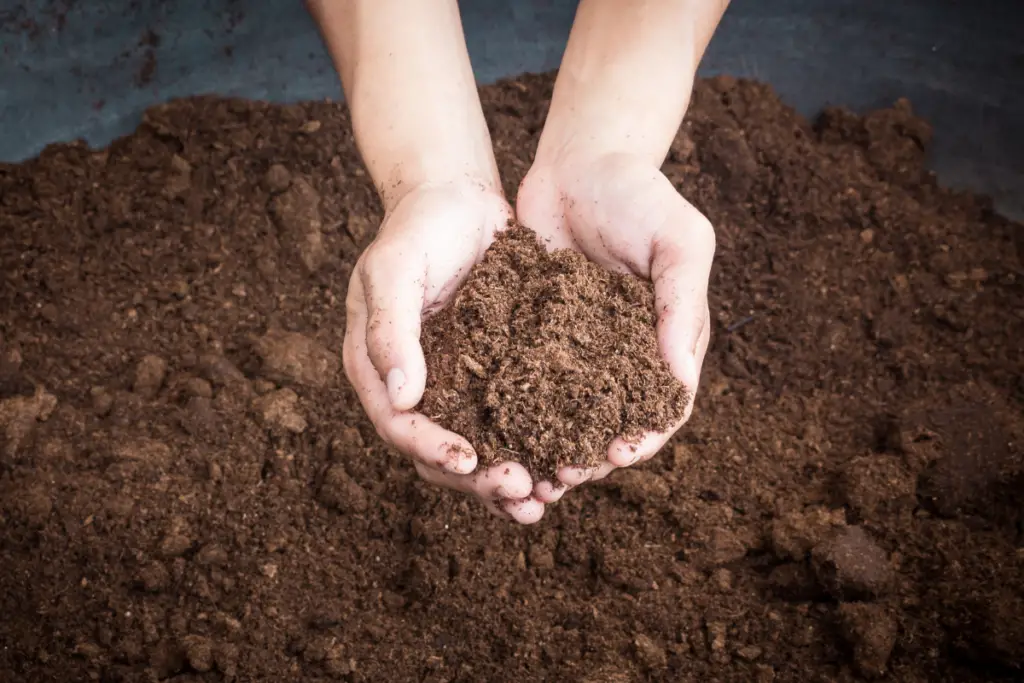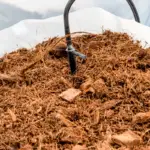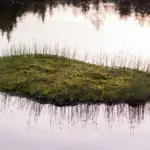Peat moss is a popular gardening material that is used to improve soil quality and moisture retention.
It is a type of organic matter that is harvested from peat bogs, which are wetland areas that have accumulated layers of partially decomposed plant material over thousands of years.
Peat moss is known for its ability to hold water and nutrients, making it a valuable resource for gardeners and farmers.
Peat bogs are found in many parts of the world, but the majority of peat moss used in gardening comes from Canada.
The process of harvesting peat moss involves removing the top layer of vegetation and then extracting the underlying peat using large machines.
Once harvested, the peat moss is dried and packaged for distribution to garden centers and nurseries.
While peat moss is a popular gardening material, there are concerns about the environmental impact of harvesting peat from bogs.

Table of Contents
Origins of Peat Moss
Peat moss, also known as sphagnum peat moss, is a natural organic material commonly used in gardening.
This moisture-absorbing material has been harvested for centuries and is a popular additive to soil mixes due to its ability to improve soil aeration and water retention capabilities.
Peat moss is formed in wetlands, particularly in bogs and fens, where dead plant material accumulates over time.
The accumulation of this plant material, mainly sphagnum mosses, forms peat.
Peat mosses form dense clumps around ponds, in swamps and bogs, on moist acidic cliffs, and on lakeshores from tropical to subpolar regions.
The plants are key components in the formation of several types of bogs in northern areas.
Most of the peat moss used in crop production comes from Canada and is composed mainly of mosses from the genus Sphagnum (of which there are 160 species of sphagnum found globally).
This is where the name sphagnum peat moss is derived from. Some countries in Europe, including Finland, Ireland, and the UK, are also contenders, but don’t operate commercial peat extraction on quite the same scale.
Peat moss is harvested by cutting and removing the top layer of living plant material. This exposes the underlying peat, which is then harvested using specialized equipment.
The harvested peat is then dried and processed to remove any remaining plant material, resulting in the final product, peat moss.
While peat moss has been a popular gardening additive for many years, its environmental impact has come under scrutiny in recent years.
The harvesting of peat moss can lead to the destruction of wetland habitats and the release of carbon into the atmosphere.
As a result, many gardeners are turning to alternative soil additives, such as coconut coir or compost, to reduce their environmental impact.
- 🌴【Coco Coir Brick】: Made of 100% natural organic coconut coir, which extracted from the husk on the outer shell of a coconut, low EC and suitable pH can provide a healthy growing environment for most flowers and plants, so it can cultivate flowers and economical plant products without soil, and can also cultivate seedlings
Prices pulled from the Amazon Product Advertising API on:
Product prices and availability are accurate as of the date/time indicated and are subject to change. Any price and availability information displayed on [relevant Amazon Site(s), as applicable] at the time of purchase will apply to the purchase of this product.
Geographical Distribution of Peat Moss
Peat moss, also known as sphagnum peat moss, is a natural organic material commonly used in gardening.
It is found in wetland areas, including bogs, fens, and swamps, throughout the world.
Here is a breakdown of the geographical distribution of peat moss:
North America
Peat moss is abundant in North America, particularly in Canada, where the majority of the world’s peat moss is extracted.
The provinces of Quebec, Ontario, and Manitoba are the largest producers of peat moss in Canada.
In the United States, peat moss is found in the northern states, including Alaska, Maine, Michigan, Minnesota, and Wisconsin.
Europe
Peat moss is also found in Europe, with the largest peat moss reserves located in Finland, Ireland, and the United Kingdom.
These countries have a long history of peat extraction and use, with peat being used for fuel, horticulture, and other purposes.
Asia
Peat moss is found in several countries in Asia, including China, Japan, and Russia.
In Russia, peat moss is found in the northern regions of the country, particularly in the Siberian and Far Eastern regions.
Other Regions
Peat moss is also found in other regions of the world, including South America, Africa, and Australia.
In South America, peat moss is found in the Andean region, while in Africa, it is found in the Congo Basin.
In Australia, peat moss is found in Tasmania and other wetland areas.
Peat Moss Formation Process
Peat moss is formed over thousands of years through a natural process that involves the decomposition, compaction, and preservation of organic matter.
Decomposition Stage
The first stage of peat moss formation is the decomposition of organic matter, such as dead plants and animals, in a wet and acidic environment with low oxygen levels.
The decomposition process is slow due to the lack of oxygen, which prevents the complete breakdown of organic matter.
As a result, the partially decomposed organic matter accumulates and forms a layer of peat.
Compaction Stage
The second stage of peat moss formation is the compaction of the partially decomposed organic matter due to the weight of the overlying layers of peat.
The pressure from the weight of the layers causes the water to be squeezed out of the partially decomposed organic matter, resulting in the formation of a dense, spongy material.
Preservation Stage
The final stage of peat moss formation is the preservation of the dense, spongy material due to the low oxygen levels and acidic environment.
The low oxygen levels and acidic environment prevent the growth of bacteria and fungi, which would break down the organic matter.
As a result, the partially decomposed organic matter is preserved and transformed into peat moss.
Types of Peat Moss
Peat moss is a natural organic material that is commonly used in gardening. It is harvested from bogs and marshes around the world.
There are different types of peat moss, each with its own unique characteristics.
Sphagnum Peat Moss
Sphagnum peat moss is the most common type of peat moss used in gardening. It is derived from the sphagnum moss, which grows in bogs and marshes.
Sphagnum peat moss is known for its ability to absorb water and retain nutrients. It is also an excellent soil conditioner, improving soil structure and aeration.
Hypnum Peat Moss
Hypnum peat moss is derived from the hypnum moss, which also grows in bogs and marshes. It has a higher pH level than sphagnum peat moss and is less acidic.
Hypnum peat moss is commonly used in horticulture and is known for its ability to retain moisture.
Sedge Peat Moss
Sedge peat moss is derived from the sedge plant, which grows in wetlands. It has a lower pH level than sphagnum peat moss and is more acidic.
Sedge peat moss is commonly used in horticulture and is known for its ability to improve soil structure and aeration.
Environmental Impact of Peat Moss Harvesting
Peat moss is an important component of many gardening and agricultural products, but its harvesting can have significant environmental impacts.
Here are some of the key issues associated with peat moss harvesting:
Carbon Emissions
Peatlands, which are the natural habitats of peat moss, contain vast stores of carbon.
Harvesting peat from these areas releases this carbon into the atmosphere, contributing to greenhouse gas emissions and climate change.
According to an Oregon State University Extension Service soil scientist, the harvesting of peat moss used by gardeners and the nursery industry to improve drainage and retain water in soil contributes to climate change.
Habitat Loss
Peatlands are unique and fragile ecosystems that provide important habitat for many plant and animal species.
The harvesting of peat moss can destroy these habitats and disrupt the delicate balance of these ecosystems.
This can lead to the loss of biodiversity and the degradation of important wetland habitats.
Water Quality Impact
Peatlands are also important for water retention and purification.
The harvesting of peat moss can disrupt the natural water balance of these ecosystems, leading to changes in water quality and quantity.
This can have significant impacts on downstream water resources, including drinking water supplies.
Alternatives to Peat Moss
Peat moss is a popular choice for gardeners and farmers due to its ability to retain moisture and nutrients.
However, it is not a sustainable option as it is harvested from peat bogs, which are non-renewable resources that take thousands of years to form.
Fortunately, there are several alternatives to peat moss that are more environmentally friendly.
Coconut Coir
Coconut coir, also known as coco peat or coir peat, is a byproduct of coconut processing and is rapidly gaining popularity as the best-known alternative to peat moss.
Coconut coir is made from the fibers between the shell and outer covering of coconuts. It has excellent water retention properties and is pH neutral, making it suitable for a wide range of plants.
Compost
Compost is another good substitute for peat moss. It is rich in microorganisms that benefit the soil in numerous ways.
Sometimes known as “black gold,” compost also improves drainage, attracts earthworms, and provides nutritional value.
The nutrient content of compost varies depending on the source materials used, but it generally contains a balanced mix of nitrogen, phosphorus, and potassium.
Perlite
Perlite is a volcanic glass that is processed into small, lightweight pellets. It is often used as a soil amendment to improve drainage and aeration.
Perlite does not hold water as well as peat moss or coconut coir, but it can be mixed with other materials to create a well-draining potting mix.
Perlite is also pH neutral and does not decompose over time, making it a long-lasting option.
Conclusion
In conclusion, peat moss is a unique and valuable soil amendment that has been used by gardeners for centuries.
It is a type of decomposed plant material that is found in boggy areas around the world.
Peat moss is formed over thousands of years as plants die and accumulate in waterlogged areas, where they decompose very slowly due to the lack of oxygen.
This process creates a dense, fibrous material that is highly absorbent and has many beneficial properties for plants.
While peat moss is a popular choice for gardeners due to its ability to improve soil structure, retain moisture, and provide essential nutrients, it is important to consider the environmental impact of its harvesting.
Peat bogs are fragile ecosystems that play an important role in carbon sequestration and the preservation of biodiversity.
Therefore, it is important for gardeners to consider more sustainable alternatives to peat moss, such as coconut coir or palm peat.
By being mindful of the source of their soil amendments, gardeners can make a positive impact on the environment while still achieving healthy and productive gardens.
- How to Dry Basil Leaves: A Professional Guide
- Is an Avocado a Fruit or Vegetable? Simple Answer and Explanation
- Does Pineapple Have Seeds? Exploring the Anatomy of Pineapples
- Blooming Through Winter: Can I Grow Vegetables Indoors in the Winter?
- What Can You Grow in a Greenhouse All Year Round: A Guide to Year-Round Greenhouse Gardening
- Are Blueberries Blue? Debunking the Myth of Their Color

















